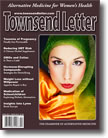This paper was presented at the seminar of Integrative Oncology, October 7, 2006, sponsored by the Vilnius University Faculty of Medicine and the Lithuanian Society for Immunology. Serge Jurasunas was invited by the dean of the Faculty of Medicine to deliver a two-hour seminar on integrative oncology.
Abstract
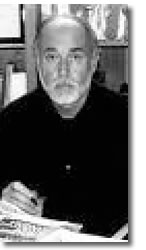 Early screening, adjuvant, and sequential systemic treatment, including chemotherapy, radiation, and hormonal therapy, have benefits in the treatment of breast cancer. However, recurrence remains high, and breast cancer remains the number one killer in women with 212,000 cases and 40,000 deaths per year.1 Early screening, adjuvant, and sequential systemic treatment, including chemotherapy, radiation, and hormonal therapy, have benefits in the treatment of breast cancer. However, recurrence remains high, and breast cancer remains the number one killer in women with 212,000 cases and 40,000 deaths per year.1
Widespread evidence suggests that breast cancer patients who have completed surgery, chemotherapy, and radiation have an immunologic deficit; and in some studies, this has been associated with a poor prognosis.2,3
Summary
The author has gained considerable experience in treating advanced and metastatic tumors with a multitargeted approach in therapy and functional food in order to challenge cancer from several directions.
This case was designed to determine whether the synergic combination of various natural compounds from new directions in cancer treatment could be beneficial in advanced metastatic breast cancer by increasing chemotherapy effectiveness, decreasing toxic side effects, and increasing quality of life. Opponents insist that the potential for harm is too great to warrant the risk of concurrent administration.4 However, our clinical work based on over 40 years of experience may, on the contrary, demonstrate the benefit of antioxidants and other natural compounds to use concurrently with biomedical therapy.5
Complementary Alternative Therapy
Antioxidant therapy
Immuno enhancement
Angiogenic therapy
Stem cells therapy
Intra-intestinal environment improvement
Diet therapy
Detoxification
|
Low molecular antioxidant compound
Anoxe – SOD like activity
MGn3 – Enzyme yeast cells
Life yeast cells
Fresh Bamboo leaf extract
L.C.E. Antioxidants
Umbilical cordon
Mesenchyme
Antolysat of human bacteria
Probiotics
Serge Jurasunas nutritional system
Energy Sand Bath
CGF
Detoxify drinks |
Introduction
We perform complementary alternative therapies, developed over the past few decades, on progressive cancer patients who respond negatively to cytotoxic treatment with strong adverse effects and increasing metastasis. Chemotherapy decreases antioxidant status in blood circulation, which in turn promotes inflammation and overexpresses cyclooxygenase 2 (COX-2) in malignant tissue, especially higher in metastatic conditions involved in tumor development and progression.6
The aim of the therapy is to reduce adverse effects from chemotherapy by means of functional foods that have biophylactic activity, increase the efficiency of chemotherapy, and put cancer cells into a dormant state. At the same time, a multitargeted therapy may reduce the number of chemotherapy cycles but with the same therapeutic results, and prevent the excess of chemotherapy that can develop by selection, mutation, and clonage-resistant cells, a population very resistant to chemotherapy.
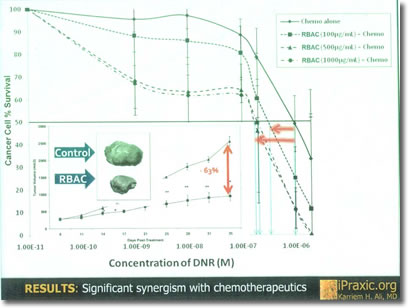
The Therapy
The treatment is based on a combination therapy that has been experimented with over the past number of years, consisting of natural compound that has a synergic effect. This includes an antiangiogenic therapy from a liquid cartilage extract (LCE) that contains only the molecules that keep the activity of angiogenesis in balance. In vitro and clinical phase III results have shown inhibitory properties of LCE on vascular endothelium growth factor (VEGF) and matrix metalloproteinases (MMPs), a special class of enzymes that the tumors use to cleave the fibrous proteins of the ECM to invade or to make new blood vessels from epithelial cells. LCE plays a crucial role in inhibiting the angiogenic mechanism in tumor growth or tumors resistant to standard therapy.7
Immunomodulation
The product is an arabinoxylan extract from rice bran hydrolyzed with shiitake mushroom extract that has strong immunomodulating properties and which enhances virtually every component of the immune system without toxicity, even long term. The compound has demonstrated strong stimulation of the NK cell activity, particularly in prostate and breast cancer.8 The arabinoxylan extract, by regranulating NK cells, gives them back their firepower to destroy cancer cells and has been included in our protocol for the past 10 years, as we believe that it surpasses the best other immunomodulating compounds made from mushrooms or herbs.
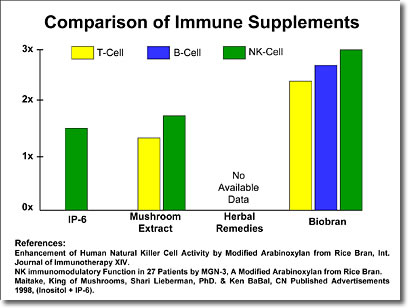
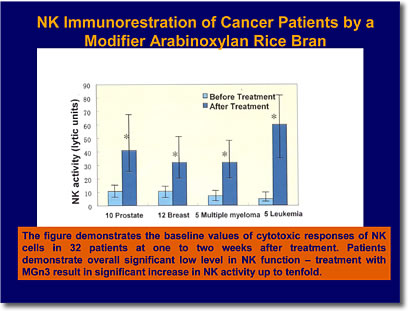
Clinical results with arabinoxylan extract in breast cancer have been quite encouraging, with reductions of tumor markers, reducing adverse effects, and long-term stabilization of remission.9
Results increase if we use conjointly an angiogenic therapy to starve the tumors, which become weaker and shrink. The result is numerous dead and dying cells more easily recognized as targets by immune cells.
Antioxidant Therapy
Antioxidant cancer therapy is now well documented, and many papers have shown that it plays a pivotal role in cancer, both in protecting healthy tissue from adverse effects and possibly inducing apoptosis of cancer cells but not healthy cells.10,11
The antioxidant compound jointly used in the combination therapy is basically a low molecular antioxidant compound made from modified vegetables and seeds rich in antioxidants having a SOD-like activity.12 It contains vitamins A, C, and E, beta-carotene, glutathione, catalase, polyphenols, flavonoids, catechin, and riboflavin.
The oral intake of the compound is quickly absorbed by the body with a strong effect against excessive ROS activity and in vitro inhibits COX-2, usually overexpressed in breast cancer.13,14
This suggests that the antioxidant compounds play a key role in modulating inflammation of healthy tissue, protecting from cytostatic side effects and, presumably, invasive malignant growth. Other tests in vivo/in vitro suggest that this molecular antioxidant compound has a strong redox potential and may induce apoptosis. Additionally, oxidative stress reduces the immune response, and therefore, by decreasing the oxidative load, we presumably increase the immunoenhancing effect of arabinoxylan extract; thus the synergic effect.
Case Presentation
A 50-year-old female with a metastatic recurrence breast cancer.
Evaluation of the Patient's Condition
The hospital provides radiography, bones scans, tumor antigen markers, blood parameters.
Alternative Check-Up
The alternative approach is useful to determine the metabolic condition, oxidative stress status, and energy level (QL) using the modern computerized device Vega Check, which monitors the electromagnetic field status, including other valuable information on a digital display. Tests are done each month, including a questionnaire at the first consultation and monthly discussions including psychological support to evaluate quality of life.15
Clinical Course and Events
The patient, with a history of cancer in the left breast diagnosed in 2000, mastectomy chemotherapy and radiation, a recurrence in 2004, and multiple lesions disseminated in the skeleton, visited our clinic in June 2005. She was quite depressed, very weak, and unable to walk without crutches. She suffered from strong pains localized in practically the entire skeleton, with more lesions disseminated after the new protocol of chemotherapy. Her condition had worsened, and a new scintigraphy done on May 6, 2005, showed more lesions disseminated and loss of bone density in the legs compared with the last test, done in April 2004. Therefore, after one year of chemotherapy, the clinical situation clearly demonstrated a poor response and evolution of the disease.
Usually, a recurrence of breast cancer shows much more resistance to drugs that when initially treated by conventional therapy and may explain why patients are more affected by its adverse effects. Beside strong pains in the bone that required anti-inflammatory drugs to relieve, the patient suffered adverse effects from chemotherapy, including nausea, vomiting, and fatigue, loss of weight, diarrhea, liver stress, nerve dysfunction, anxiety, and anemia. The incidence of anemia can be as high as 90% with some chemotherapeutic agents and can interfere with drug efficacy, as well as having a negative effect on clinical outcome.16,17
Karnowsky score: 50
Vitality status: 47%
Blood Parameters
RBCs: 3.7400000
WBC: 8.600
Hemo: 9.5
Ptl: 6330000
P.C.R.: 26.3 Mg/Dl
V.S.: 1h 130mm/h
Cancer antigen CA15.3: 113 ul/ml
Normal standard up to 30 ul/ml
The Protocol
Arabinoxylan extract from rice bran (RBAC)
Sachet containing 1g of the rice bran arabinoxylan derivative in granules
Daily dose: 3g
Liquid Cartilage Extract (Comitris)
Frozen vial of 30 ml
Daily dose : 1 vial
Enzyme yeast cells preparation
20 ml to mix in a large glass of carrot and red beet juice and add one tablespoon of liquid chlorophyll 3 times per day.
Small Molecules from Porcine Embryonic Source (Biorejan)
(umbilical cord, mesenchyme, spleen) Frozen vial of 7.5 ml
Daily dose: 1 vial
Low molecular antioxidant compound from modified vegetables having a SOD-like activity (Anoxe)
Sachet of 3g of granules
Daily dose: 18g
Energy sand bath (SGES)
Daily dose: 50 g of the powder to dissolve in hot water bath
Frequency: 3 times per week
Temperature: 38 ºC
Time: 30 minutes18
Functional food, raw vegetable diet, and raw fresh organic vegetable juices are suggested to improve the patient's nutritional state, since chemotherapy decreases most nutrients in blood circulation. (Food quality and diet in cancer – see www.sergejurasunas.com)
New Consultation
Over 3 to 6 months, the patient rapidly improved, especially with far fewer adverse effects from chemotherapy. After 2 months, she walked by herself, pains decreased, and she had no more need of the anti-inflammatory drugs. She had more mobility and can go up to the second floor of our clinic without crutches.
After 3 months, a new bone scan showed a 100% elimination of the large lesions on the ileum and spine. Tumor markers CA15.3 decreased by 50% to 55.2 u/ml and CEA to 2.6 ng/ml.
New blood parameters showed much improvement, including a decreasing sedimentation.
RBCs 4310000
Hemo: 13.6
WBCs: 6.800
Ptl: 327000
V.S.: 1h 63mm/h
We have reason to believe that during chemotherapy the patient improved her blood parameters by taking our treatment, and probably avoided blood transfusion. As seen in the figure (p. 69), over the months the blood parameters steadily improved and kept stable.
A new bone scan done in February 2006 showed an almost complete resolution of cell lesions disseminated on the skeleton compared with the first bone lesions. Lesions on the brainpan we are almost totally eliminated, and on the first bone scan we observed a total loss of the bone density structure of the legs subject to pathological fractures or to a drug treatment to prevent skeletal events; on the new bone scan we observed a total recuperation of the bone structure with excellent density.
The other good news is a steady decrease of the antigen tumor marker CA 15.3, which is now 23.6 ul/ml and ACE to 0.7 ng/ml. PCR, which was 26.3 mg/dl at the beginning, decreased to 0.5 mg/dl, showing a significant decrease of inflammation responsible for activating metastatic invasion.
The patient felt much better and stronger, had substantially increased the Karnowsky score to 100, and the result from the Vega check electromagnetic field was now 82%. Now the patient could live her normal life with better quality and return to her profession as a physiotherapist.

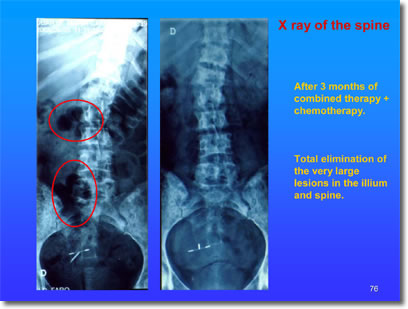
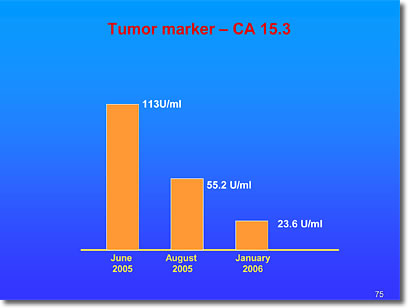
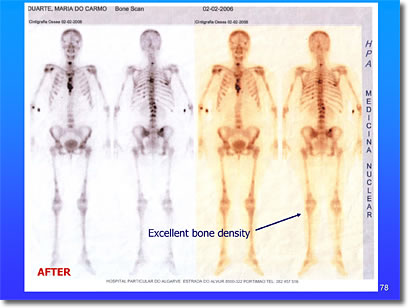
Discussion
The number of patients with breast cancer and recurrence with multiple metastasis to target organs and the skeleton is increasing in Portugal and all the European Union.
Recurrent cases of breast cancer from surgery and chemotherapy (Lancet. 2001;357:1048) with bones metastases and return to new treatment have an overall survival rate of 15 to 20 months. Indeed, our patient above suffered poor results and was in critical condition at the first visit. Recurrence of breast cancer is a consequence of surgery and chemotherapy that together account for 40% to 60% of developing metastatic conditions and increasing death (Lancet. 2001;357:1048).
Carcinoma of the breast has an affinity for bone and is reported in 73% of all breast cancer. Six more months of chemotherapy extension without a multitargeted therapy and nutritional approach could have been of serious consequence for the patient entering an advanced cancer state.
Additionally, the energy level (QI factor) may be an important element that allow doctors a greater degree of control over a patient's health, thus leading to better recovery from the disease.
The results obtained over a 9-month period suggest that the combination therapy experimented on with this patient has been positive and demonstrate that a multitargeted approach to cancer with natural agents is more effective that chemotherapy alone. Our combination therapy demonstrates efficiency in a clinical setting. LCE is critical to inhibiting a tumor's blood vessels with additional anti-inflammatory properties. LCE is necessary in any case of bone metastases. Enzyme Yeast Cells have been included in our treatment for 38 years and not only work as a food supplement but also increase cellular respiration and restore mitochondrial function to in turn decrease tumor growth.19
This treatment is an option for breast cancer recurrence with metastatic condition, with better outcome and improved quality of life.

Notes
1. Jemal A, Murray T, Ward E, et al. Cancer statistics 2005. CA Cancer J Clin. 2005;55:10–30.
2. Ben-Eliyahu S, Page GG, Yirmiya R, Shakhar G. Evidence that stress and surgical interventions promote tumor development by suppressing natural killer cell activity. Int J Cancer. 1999: 80:880–88.
3. Claude L, Perol D, Ray-Coquard I, et al. Lymphopenia: a new independent prognostic factor for survival in patients treated with whole brain radiotherapy for brain metastases from breast carcinoma. Radiother Oncol. 2005;76:334–339.
4. Seely D, Oneschuk D. Interactions of natural health products with biochemical cancer treatments. Oncology. 2008;5(suppl 2):109–110.
5. Jurasunas S. A review of clinical cancer cases: treated by complementary alternative therapies base on the clinical strategy of Dr. Serge Jurasunas. Slovakia: D.H.D. Europe; 2007.
6. Koki AT, Masferrer JL. Celecoxib: a specific COX2 inhibitor with anticancer properties. Cancer Control. 2002:9:28–35.
7. Thibodeau A, Bilodeau D. Angiogenesis and P-glycoprotein: their roles in cancer. Townsend Lett. June 2002;227:97–104.
8. Ghoneum M. Effects of MGN-3 on human natural killer cell activity by modified arabinoxylan from rice bran. Int J Immunotherapy. 1998;14(2):89–99.
9. Ghoneum M. Immunomodulatory and anticancer property of MGN3, a modified xylase from rice bran, in 5 patients with breast cancer [abstract]. American Association for Cancer Research Special Conference: The Interface Between Basic and Applied Research. November 1995; Baltimore, MD.
10. Greenberg et al. Therapeutic use of antioxidants modulation of redox signal transduction pathways in the treatment of cancer. Antioxid Redox Signal. 2001;3(3):347–359.
11. Weiss JF, Landauer MR. Protection against ionizing radiation by antioxidant nutrients and phytochemicals. Toxicology. 2003;189:1–20.
12. Niwa Y, Myachi Y. Antioxidant action of natural health products and Chinese herbs Inflammation. 1986;10:79–91.
13. Ionescu J, Jurasunas S, Weber D. Effects of natural SOD like compound on redox potential and free radical generation in venous blood and plasma. Spezialklinic Neukirchen Research Dept. Germany; 2002.
14. Nair MG, Jurasunas S, Tavares N. Cyclooxygenase enzyme inhibitory property of Anoxe. National Food Safety and Toxic Center Michigan State University. 2005.
15. Anderson BL. Psychological interventions for cancer patients to enhance the quality of life. J Consult Clin. 1992;60:552–568.
16. Groopman JE, Itri LM. Chemotherapy-induced anemia in adults: incidence and treatment. J Natl Cancer Inst. 1999;91(19):1616–1634.
17. Dermetri GD. Anemia and its functional consequence in cancer patients: current challenges in managements and prospects for improving therapy. Br J Cancer. April 2001;84(51):31–37.
18. Jurasunas S. A far-infrared ray emitting stone (SGES) to treat cancer and degenerative disease. Townsend Lett. June 2000.
19. Jurasunas S. Orthomolecular treatment of cancer. Townsend Lett. Feb/Mar 1999.
Serge Jurasunas is an internationally well-known doctor of naturopathy and alternative medicine with over 40 years of experience in the treatment of cancer. He is pioneering innovative therapies in cancer treatment, and many of his articles on methods to treat cancer are published in 12 languages. Dr. Jurasunas has lectured in over 35 countries and delivered cancer seminars to medical faculties in universities. Today Dr. Jurasunas is busy working with the P53 tumor suppressor gene and other molecular markers related to cancer patients, with results to be published in the near future.
For more information and to learn about cancer treatment and clinical cases at Holiterapias Clinic, see www.sergejurasunas.com.
info@sergejurasunas.com; phone: +351 21 3471117
|



![]()
![]()
![]()
